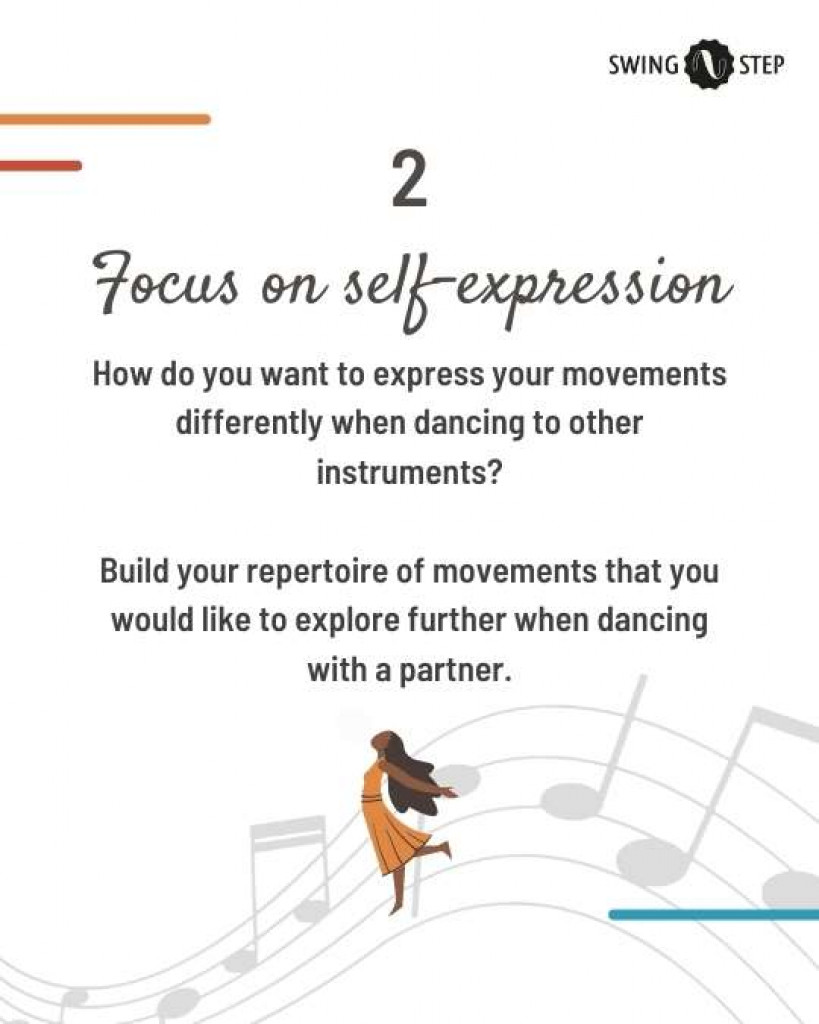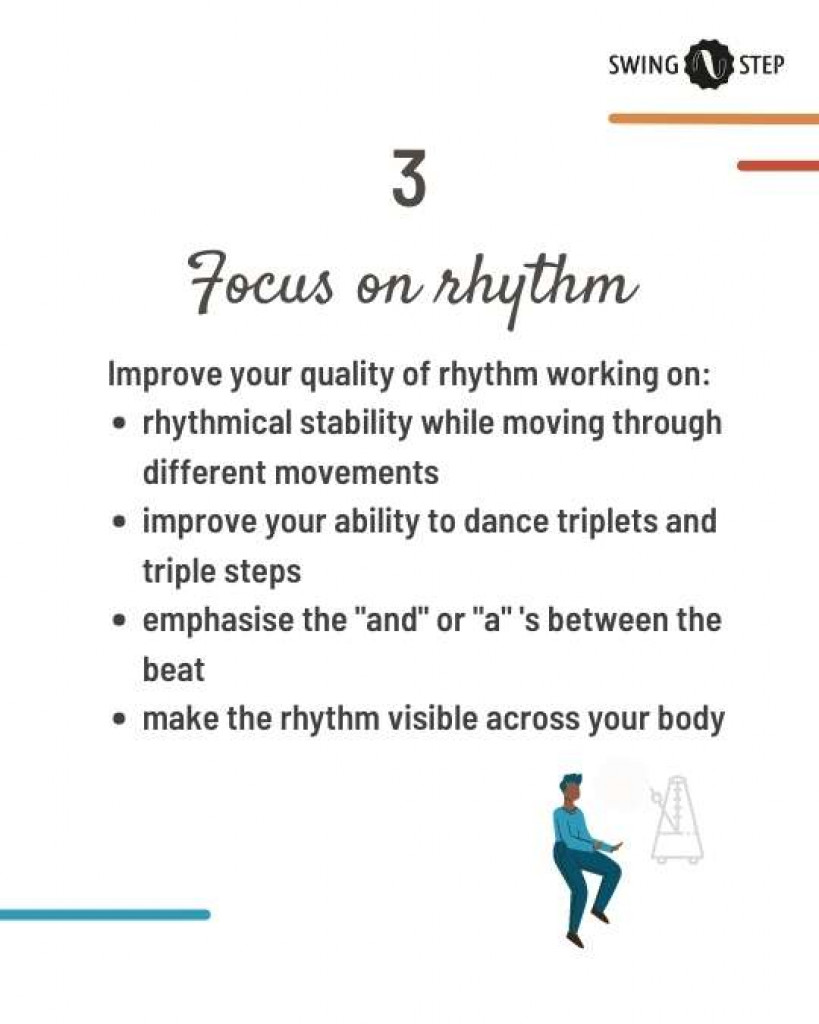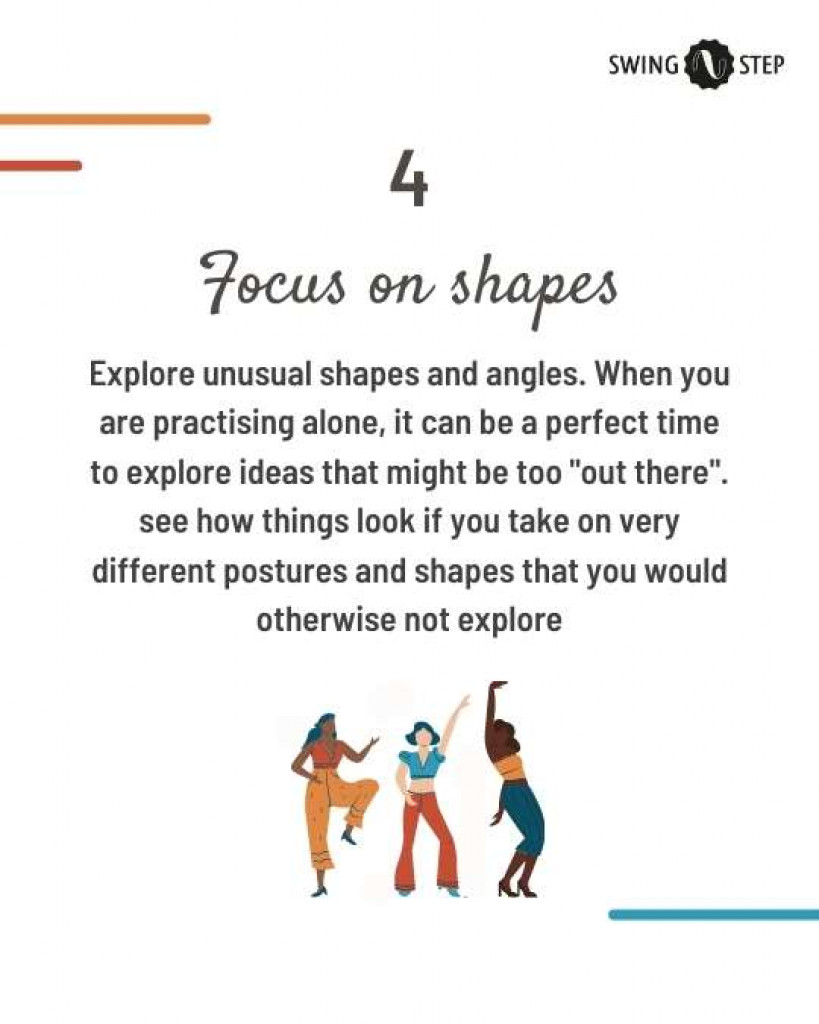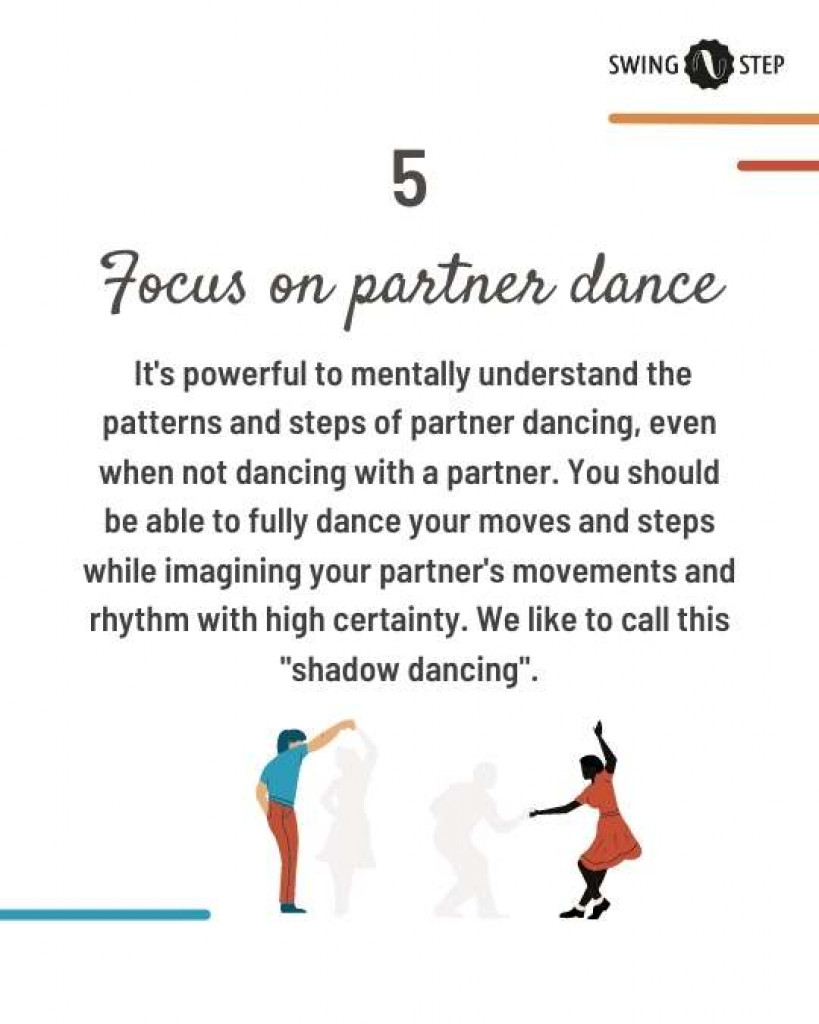
A simple guide for practicing partnered dance alone
The process of practising dance is not easy. Practising partnered dance alone is even that much more difficult. However, practising alone can be delightful with the tips you’ll learn here. Some of the challenges we need to overcome are knowing what to work on, how to give ourselves feedback, and how to make it engaging enough to come back to it repeatedly.
Here we share with you what tools you can use when practising Lindy Hop alone, what you can practice, and what mindset will help you grow as a dancer.
A Music Device
Perhaps the best place to start is to make sure you have a device that plays music. Perhaps the most common choice is a laptop or smartphone. What’s great about a device with access to a web browser is that you can quickly get access to the songs you like. But also, you’ll have access to other tools such as a digital metronome. Search for “metronome” on your browser, and you’ll find several options. If needed, you can use software to slow down or speed up your music. Or use youtube to watch a video for inspiration. Search for a “bpm calculator” in your browser, and you can quickly access a tool that lets you know the tempo of your songs. But even more, actively doing historical research will help you learn more about the background of the steps and ideas you are learning.
Action Step: Create a favourites folder on your browser where you save the links to the resources you want to use for your practice. This way, you don’t have to spend too much time searching for them while practising.
A notebook
Having something to write your thoughts on is a powerful tool to help you with the process of practising. You can use it to diary what you’ve been working on, noting down your thoughts, experiences, and ideas that come to mind. However, what helps a lot with motivation for a practice session is to write down ideas on what you want to practice BEFORE you start practising. Entering a practice session unprepared creates too much risk of feeling overwhelmed and uninspired. The sessions can too quickly end up composed of a few random ideas that rapidly feel pointless. You end your training too early and leaving with a bad experience that makes starting the next training session emotionally harder.
Action step:
- Separate the planning from the practice moments.
- For every couple of hours of training, dedicate at least 30 minutes to design what you want to train.
- During the planning phase, look for inspirations, ideas, and tactics for what to practice.
A camera
This obvious and often overlooked tool is an excellent way of separating the analysing process from the actual dancing moment. I’ve noticed that those who don’t consider themselves “professional” dancers don’t reach for their smartphones to record themselves dancing and thus leave out this important tool for visual feedback. If you’ve never filmed yourself, you might need time to get used to it.
Especially when practising alone, filming is so powerful because when it comes to new movements and modes of expression, we can’t rely on the internal feeling alone for feedback. By default, most new movements will feel weird and foreign to us. So, suppose you want to explore dancing where you change how you take steps, carry your body, or approach a move. In that case, you might need to endure feeling weird and awkward before it becomes familiar, comfortable, and “right” for you. Recording yourself dancing can provide a different perspective. It allows you to see if what you do is taking you closer to your goals or not. The visual might not match the emotional, and having access to both can help you determine how you want to progress.
Action step: If you don’t already have a tripod, consider purchasing one. This significantly affects how well you handle the process of recording and watching your dancing. If you don’t want to budget for a tripod, you can be creative and use props to hold up your phone at the right angle. However, be careful that your phone does not tip over the edge of a chair or table and break.
Props
You can also explore the use of props for your practice. For example, a prop can be a physical object you place on the floor to give yourself external feedback while moving. This feedback can help you better correct your movements in the process. For example, you could be taping lines on the floor that you dance on or avoid touching. You might use ropes and rubber bands to represent a partner’s hand to explore “connected” movements. Or, you might use walls, doors, tables, and chairs to create objects to support your practice in different ways.
Action Step: Plan what you need for a specific objective. However, from our experience, we don’t recommend you re-create the experience of dancing with a partner using these objects but instead focus on specific concepts you want to refine.
If you still feel stuck with how to use these tools to practice Lindy Hop without a partner, you can use our “Skills and Drills for Leaders and Followers” – course. In these courses, we guide you through many ideas for how you can practice Lindy Hop without a partner. In addition, we are sharing the first class for free in our Free-Video series for experienced dancers: https://swingstep.com/classes/free-lindy-hop-videos-for-experienced-dancers/.
What can we practice when we practice alone?
Especially with partnered dancing, practising alone might seem like a non-starter. So how will that help you explore your partner dancing further? Here are several ideas:
Learn which songs are fundamental for Lindy Hop and study them.
Listening to the music and letting that experience guide a lot of your movements and choices is a great place to start when it comes to practising partnered dancing alone. The music plays for both leaders and followers. So it helps to be deeply familiar with the songs no matter what role you typically dance in.
Also, learn about the historical context of the songs. Who were the songwriters and composers? What are the popular renditions of these songs? How does that change from version to version? Which version is your favourite?
Learn these songs by heart as much as possible. For example, see if you can sing the melody line (approximately is enough). What musical structure does it follow, what are the melodic progressions in this piece, and what riffs are dominant? And importantly, understand the song in general, perhaps with less focus on a specific version of the song. You’ll soon notice what a difference it is to your quality of dancing when you dance to a song you know well compared to a song you know less well.


Develop your ideas on how you would like to express yourself in different songs.
For example, explore what moves and gestures work for you while dancing. How do you want to express your movements differently when dancing to other instruments? For instance, try exploring moving differently to moments of a song that is drum-heavy compared to, for example, trumpet-heavy. Or, what if the song is accentuating the 8 and the 1? Would you do something different there? In other words, build your repertoire of movements that you would like to explore further when dancing with a partner.
Improve your quality of rhythm.
Rhythmic quality comes from several factors that come together. Some of these factors include:
- Your rhythmical stability as you move through different movements at an increasing degree of complexity. To practice this, you can use a metronome to see how consistently you maintain the rhythm and don’t accidentally speed up or slow down as you go through your movements.
- You want to improve your ability to dance triplets and triple steps when dancing to swing music. As well as how well you dance behind the beat
- You can create nuances such as your ability to emphasise the “and” or “a” ‘s between the beats.
- How well you can see the rhythm across your entire body even when you mute the video (assuming you filmed yourself dancing and are watching it).


Explore unusual shapes and angles.
Especially when you are practising alone, it can be a perfect time to explore ideas that might be too “out there.” Sometimes exploring something new and different can be too daunting in front of others. While alone, see how things look if you take on very different postures and shapes that you would otherwise not explore (at first) with other dancers in the room.
Visualise the partner dance.
It’s powerful to mentally understand the patterns and steps of partner dancing, even when not dancing with a partner. This skill can help you a lot with all sorts of situations. For example, you can better adapt your positioning toward your partner when you can visualise how your partner moves in space; you can better adjust your positioning toward your partner. However, this process can quickly feel impossible if you have little experience visualising your partners’ movements. Just treat this like training any other move. Start from scratch and don’t carry the expectation that just because you’ve danced it a lot with a partner, you should be able to move through the same patterns without the partner. Instead, practice the movements from scratch like you are learning them for the first time and work towards better visualising complex partner movements without a partner. You should be able to fully dance your moves and steps while imagining your partner’s movements and rhythm with high certainty. We like to call this “shadow dancing.” When you have the skills to visualise a partnership, you can also start exploring ideas for new moves and sequences.

If you want ideas for practising your Musicality, look at our “Musicality Training” course. Here, we guide you through ways to improve your sense of rhythm and different music theory concepts. In addition, we share the entire first lesson of this course in our Free-Video series for experienced dancers: https://swingstep.com/classes/free-lindy-hop-videos-for-experienced-dancers/.
Mindset for Learning
If you’ve ever heard others, or found yourself, saying anything like:
- “It’s not my strong suit.”
- “Oh wow, you’re so smart.”
- “You dance so nicely; you must be talented.”
You or the person you heard fell into a moment of having a “Fixed Mindset.” I learned this concept from a great book called “Mindset: The New Psychology of Success” by Carol Dweck. In this book, Carol Dweck introduced the idea that we have “Fixed” and “Growth”- mindsets, and as you probably assumed from the names, when learning, taking on a “growth mindset” will help a lot.
Although I always prided myself on being a “growth mindset” kind of person, what stood out to me was the idea that we are never just “one.” Instead, our mindset can be more or less fluid depending on circumstances. For example, I always considered myself not talented in singing. I love to sing, but I’m not good at it. But now I know that even expressing this using words like “talented” or “it’s not for me” indicated a “fixed mindset” in this domain of my life.
Instead, it is also a fact that I grew up in a family that loved dancing and emphasised that much more than singing. I never had any training in singing and never tried to learn any singing techniques with enough dedication to make a difference. So what might be a more appropriate way of thinking is that I’m not good at singing YET, and I have not put in the effort to learn it. I find the word “yet” to be very powerful as it implies that if I want, I can learn it.
Now, back to dancing. Where have you found yourself having a fixed mindset? For example, you might be saying, “I am not good with the solo stuff,” or “Musicality is too hard for me; I just like [insert what you feel good at within the dance]. ”
Dance skills are not something we are born with (fixed). Instead, it comes from the work we put into learning the skill (growth).
When we face something about the dance that is challenging, are we trying to avoid it (fixed)? Do we give up easily (fixed)? Or do we embrace the challenge (growth) and show persistence towards it (growth)?
Do we see the expenditure of effort as something that should be unnecessary (fixed)? Something you do only when you are not good enough (fixed)? Or as an essential path towards mastery?
When we receive feedback about our dancing, do we get defensive and take it personally (fixed)? Or do we see it as something valuable that can help us learn and improve (growth)?
When we feel we are not making progress, do we put the blame on others and get discouraged (fixed)? Or do we use it as a wake-up call to work harder next time (growth)?
Another thing that stood out from Carol Dweck’s book is how influential we can be in spreading a fixed or growth mindset to the people around us. For example, we emphasise the growth mindset by focusing our praise on effort, processes, and strategies rather than results and talents. We can aim to raise our, or others, growth mindset rather than striving to boost self-esteem. Small personal micro celebrations can also help boost our growth mindset. However, it’s essential to make the celebration about the process and effort rather than the result itself.
With this, you now have a few tools and ideas for getting started with practising your dancing. What’s great about practising alone is that you don’t have to wait for anyone. You can do it whenever you want. Perhaps you even decide to take a few minutes right now and plan a session.